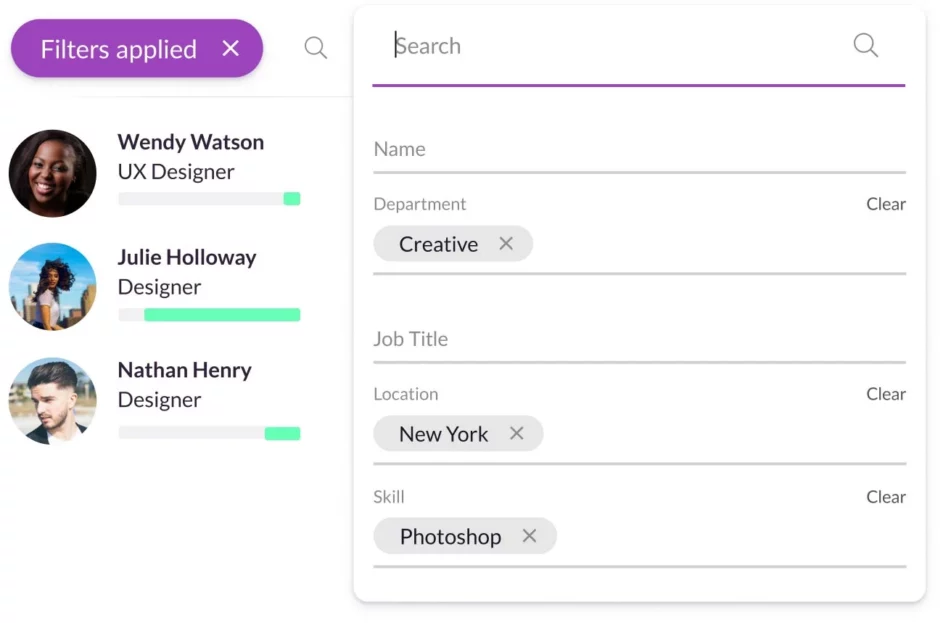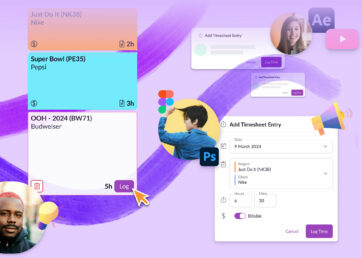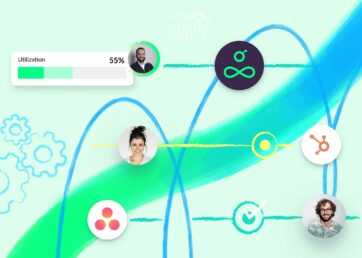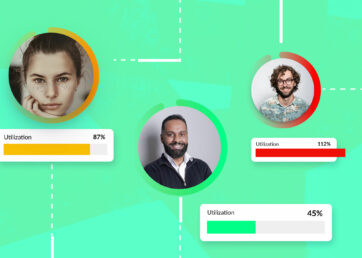Capacity planning plays a key role in agency profitability. Do it well and you’re looking at some healthy margins and business growth. Do it less well? Now, you’re looking at some serious employee, culture, and workflow problems, not to mention declining client happiness.
Safe to say, there’s a lot riding on agency capacity planning. So from strategies to best practices, we’re here to help.
In this article 📖
What is agency capacity planning?
Agency capacity planning is about optimizing resource allocation to ensure that your agency can meet project demands, improve agency efficiency, increase profitability, and deliver on client expectations.
In other words, are the right people available, and do you have enough of them?
Not only can agency capacity planning help you forecast the employee numbers you’ll need to complete future projects. But it can also help you to maximize profits while preventing burnout at the same time.
3 key benefits of agency capacity planning
There are many benefits for your agency when it comes to capacity planning. From increased productivity to improved client satisfaction.
But the core benefits that ultimately lead to many other advantages are these:
- Optimized utilization rates
Capacity planning is all about optimizing allocation and utilization. You want to get the right people on the right projects while preventing overloading or underutilizing employees.
- Increased efficiency
Capacity planning promotes efficiency by preventing resource bottlenecks and idle time. When resources are allocated optimally, projects can progress smoothly, reducing delays and rework.
- Improved profitability
Efficient capacity planning can improve profitability by reducing resource waste and cost overruns. Plus, it’ll help you better estimate project costs and allocate resources effectively to maximize margins.
5 types of agency capacity planning
Depending on your agency’s team structure, workflows, and project needs, there are different types of approaches to capacity planning.
These are five of the most common approaches:
- Resource-based
In this approach, agencies assess their available resources, including employees, skills, and equipment, to determine their capacity for taking on new projects. It involves evaluating the skills and availability of team members to match them with project requirements. - Project-based
Agencies may plan their capacity on a project-by-project basis. They assess the resource requirements of individual projects and allocate resources accordingly. This ensures that each project has the necessary resources to deliver project success. - Client-based
Agencies may allocate resources based on client priority or account value (in other words, how much they’re paying you). High-value clients or long-term contracts may receive priority in resource allocation to maintain strong client relationships. - Time-based
Time-based capacity planning focuses on scheduling resources over specific time periods, such as daily, weekly, monthly, or quarterly. It ensures that there’s a balance between resource availability and project timelines. - Growth-based
Growth-based capacity planning aligns capacity with long-term agency growth objectives. It involves evaluating resource needs over an extended time period and making strategic investments in talent and infrastructure.
Agency capacity planning strategies
Here are the three capacity strategies you can use to increase agency productivity and meet client demands.
- Lead strategy—Forecast future resource demands
This method involves focusing on future client demands. For instance, you hire five new employees because you anticipate more demand. The downside to this bold method is that you can end up with many employees and little work because your predicted demand increase didn’t happen. - Lag strategy—Respond to resource demands as they happen
The lag strategy is reactionary as you respond immediately to client demands. Let’s say you receive a request for design work, so you quickly hire one extra designer. However, if there is an increasing demand for your work, you might struggle to find freelancers quickly enough. This issue is where the lag strategy got its name. - Match strategy—Monitor and adjust resource demand
As a combination of the lead and lag strategies, the match strategy involves careful monitoring of the current demands on your agency. You might also watch demand planning estimates and try to keep an eye on market developments.
It’s common to use a mix of these strategies depending on the nature of your agency projects.
How to do agency capacity planning in 11 steps
There’s no such thing as straightforward agency capacity planning. Not only does it involve several steps to ensure that resources are allocated efficiently, but it’s an ongoing, iterative effort that often has to adapt to changing circumstances and client needs.
Here’s how you do it:
1. Assess current resources
Begin by taking stock of your agency’s current resources, including staff, skills, equipment, and technology. But don’t take it lightly, dig deep and really understand the capabilities and availability of your team members as well as other resources, including your agency tools.
2. Understand client demands
Gather information on current and anticipated client demands. Engage with sales and client relations to get the full picture of what’s in the pipeline. Consider factors like project scope, timelines, budgets, and client priorities.
3. Set clear objectives
Define your capacity planning objectives. Are you looking to optimize resource utilization, improve project delivery times, or support agency growth? Clearly outline what you aim to achieve.
4. Identify key metrics
Establish the key performance indicators (KPIs) that will help you measure the effectiveness of your capacity planning process. These typically include resource utilization rates, project completion times, and client satisfaction scores. If there’s one metric to keep your eye on, it’s billable utilization rates. This tells you exactly how well your agency is performing financially.

Analyze billable utilization rates in Resource Guru.
5. Prioritize projects
Rank and prioritize your agency’s current and upcoming projects based on factors such as client importance, profitability, strategic alignment, and resource requirements.
6. Allocate resources
Match the skills and availability of your team members with the resource requirements of each project. Ensure that resources are allocated to high-priority projects first.

Filter by skills in Resource Guru and assign the right people to your projects.
7. Resource utilization analysis
Use your resource management tool to analyze resource utilization rates and identify areas of overallocation or underutilization. Adjust resource allocation as needed to not only optimize efficiency but also to keep your teams happy and healthy and prevent burnout.
8. Scenario planning
Work with other departments to develop scenarios for resource allocation based on different situations, such as increased client demand, resource shortages, or project delays. Have contingency plans in place. Make sure your agency traffic managers are involved throughout the process.
9. Cross-functional collaboration
Foster collaboration and communication between departments or teams to enable sharing of resources when necessary. Cross-functional teams can help balance workloads and reduce the risk of team burnout.
10. Client management
Overpromising is the killer of both projects and healthy client relationships. Set clear expectations with clients regarding project timelines and resource availability when onboarding new clients. Educate clients about the agency’s capacity limitations and communicate any potential delays or resource constraints.
11. Feedback and continuous improvement
Encourage feedback from team members, project managers, and clients regarding resource allocation and capacity planning. Use feedback to refine your agency processes and capacity planning strategies.
By following these steps and continuously monitoring and adjusting your capacity planning strategy, you can optimize resource allocation and improve your agency’s ability to deliver successful projects.
The goal? Ultimately, your capacity planning needs to support your agency’s growth ambitions.
4 agency capacity planning best practices
There are a few best practices to keep in mind when you do your capacity planning. These are a good starting point, but we also recommend developing your own best practices as you learn what’s working and not working in the context of your agency operations.
1. Put employee well-being first
Consider the well-being of your team members when planning resource allocation. Avoid overburdening employees, as it can lead to burnout and decreased productivity.
Read more about work-life balance at agencies
2. Streamline processes with tools
When you’re dealing with multiple projects there’s nothing worse than managing capacity planning in a spreadsheet. This is the time to leverage technology, such as project management software and resource management tools, to streamline and automate resource allocation processes.
Build your ideal agency tech stack
3. Hold regular capacity reviews
Regular meetings with department heads, project managers, and traffic managers to review resource allocation and capacity planning will prevent any unwanted surprises. This is when you look at project progress and adjust resource allocation based on updates and priorities.
Discover how Havas CX Canada does it
4. Create a capacity buffer
Maintain a buffer in your resource planning to accommodate unexpected resource needs or changes in project scope (but be aware of scope creep). This buffer can act as a safety net.
Agency capacity planning example scenario
Let’s look at a capacity planning scenario for a fictional digital agency, called Forge.
Agency profile:
- Forge is a mid-sized digital marketing agency specializing in website development, SEO, and social media marketing services
- The agency has 50 employees, including web developers, SEO specialists, content writers, and project managers
- Forge serves a diverse client base, including e-commerce businesses, healthcare providers, and tech startups
Capacity planning challenge:
- Forge has experienced rapid growth in client demand over the past year, resulting in increased project requests
- The agency has recently won a contract with a large e-commerce client that requires significant resources for a website redesign and ongoing digital marketing campaigns
- Project managers are concerned about the agency’s ability to meet existing client commitments while taking on this high-profile project
Capacity planning process:
- Resource assessment
Forge assesses its current resources, including the skills, availability, and expertise of its employees. - Client demand analysis
The agency reviews its current client project pipeline and identifies each project’s scope, timelines, and resource requirements. - Prioritization
The agency ranks projects based on factors such as client importance, profitability, and strategic alignment. The e-commerce client project is identified as a high-priority project due to its potential impact on revenue. - Resource allocation:
Project managers collaborate to allocate the necessary resources to the e-commerce client project. This involves assigning web developers, SEO specialists, and content writers with relevant expertise. - Capacity gap analysis:
Forge realizes that while they can allocate resources to the e-commerce project, it may strain their capacity for other projects. The agency identifies the need to hire additional web developers and content writers to maintain existing project commitments. - Scenario planning:
The agency develops contingency plans in case of unexpected resource shortages or project delays. This includes identifying freelancers who can be brought in on short notice. - Communication with clients:
Project managers proactively communicate with existing clients to manage expectations regarding project timelines and potential resource constraints. - Investment decision:
Agency leadership decides to invest in hiring two additional web developers and a content writer to support current projects and accommodate future growth. - Implementation:
Forge initiates the hiring process to onboard new team members. Simultaneously, they continue to allocate resources to the e-commerce project while maintaining the quality of other projects. - Monitoring and adjustment:
Going forward, Forge regularly monitors project progress and resource utilization. Any adjustments in resource allocation or priorities are made as needed to ensure client satisfaction and project success.
Outcome:
- Forge successfully completes the e-commerce client project on time and within budget, resulting in a satisfied client.
- The agency maintains its commitment to existing clients by hiring additional staff to handle increased project demands.
- Forge continues to grow its client base and reputation in the digital marketing industry by effectively managing its capacity and resources.
This scenario demonstrates how capacity planning can help agencies navigate a challenging growth period, ensure client satisfaction, and strategically invest in their future success.
Agency capacity planning: The path to profit
Getting capacity planning right isn’t easy. It takes constant monitoring, tweaking, and adjusting. But with best practices in place, while putting your employees first, you’ll be able to stay on top of capacity planning while meeting client needs.
The key lies in a proactive approach.
Remember, capacity planning is not just a short-term solution—but a long-term investment in an agency’s sustainability and growth.





